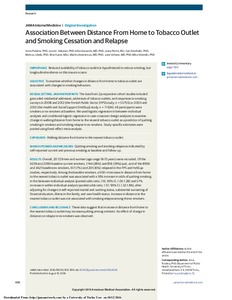Association Between Distance From Home to Tobacco Outlet and Smoking Cessation and Relapse
Anna Pulakka; Jaana I. Halonen; Ichiro Kawachi; Jaana Pentti; Sari Stenholm; Markus Jokela; Ilkka Kaate; Markku Koskenvuo; Jussi Vahtera; Mika Kivimäki
https://urn.fi/URN:NBN:fi-fe2021042715571
Tiivistelmä
Importance
Reduced availability of tobacco outlets is hypothesized to reduce smoking, but longitudinal evidence on this issue is scarce.
Objective
To examine whether changes in distance from home to tobacco outlet are associated with changes in smoking behaviors.
Design, Setting, and Participants
The data from 2 prospective cohort studies included geocoded
residential addresses, addresses of tobacco outlets, and responses to
smoking surveys in 2008 and 2012 (the Finnish Public Sector [FPS] study,
n = 53 755) or 2003 and 2012 (the Health and Social Support [HeSSup]
study, n = 11 924). All participants were smokers or ex-smokers at
baseline. We used logistic regression in between-individual analyses and
conditional logistic regression in case-crossover design analyses to
examine change in walking distance from home to the nearest tobacco
outlet as a predictor of quitting smoking in smokers and smoking relapse
in ex-smokers. Study-specific estimates were pooled using fixed-effect
meta-analysis.
Exposures
Walking distance from home to the nearest tobacco outlet.
Main Outcomes and Measures
Quitting smoking and smoking relapse as indicated by self-reported current and previous smoking at baseline and follow-up.
Results
Overall, 20 729 men and women (age range 18-75 years) were
recruited. Of the 6259 and 2090 baseline current smokers, 1744 (28%) and
818 (39%) quit, and of the 8959 and 3421 baseline ex-smokers, 617 (7%)
and 205 (6%) relapsed in the FPS and HeSSup studies, respectively. Among
the baseline smokers, a 500-m increase in distance from home to the
nearest tobacco outlet was associated with a 16% increase in odds of
quitting smoking in the between-individual analysis (pooled odds ratio,
1.16; 95% CI, 1.05-1.28) and 57% increase in within-individual analysis
(pooled odds ratio, 1.57; 95% CI, 1.32-1.86), after adjusting for
changes in self-reported marital and working status, substantial
worsening of financial situation, illness in the family, and own health
status. Increase in distance to the nearest tobacco outlet was not
associated with smoking relapse among the ex-smokers.
Conclusions and Relevance
These data suggest that increase in distance from home to the
nearest tobacco outlet may increase quitting among smokers. No effect of
change in distance on relapse in ex-smokers was observed
Kokoelmat
- Rinnakkaistallenteet [27094]
